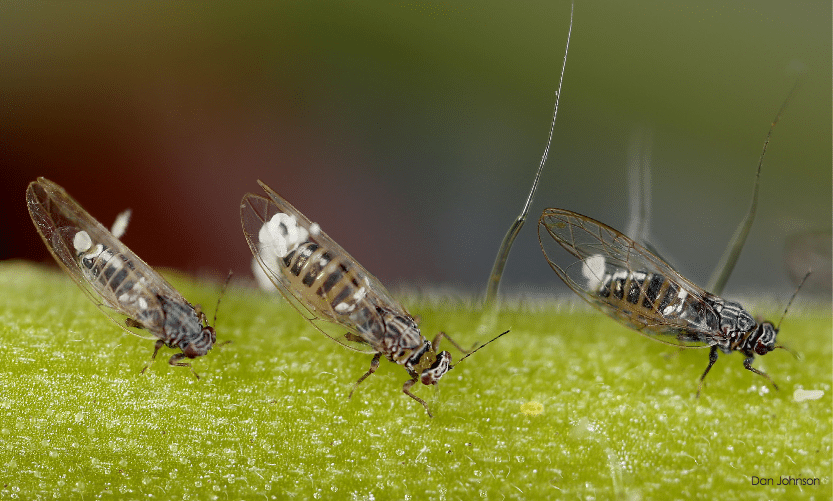Although the zebra chip pathogen Candidatus Liberibacter solanacearum (Lso) has been detected in small numbers of potato psyllids in two sites in Alberta, no zebra chip symptoms or pathogen has been found in potato plant tissue.
During three years of sampling for potato psyllids (Bactericera cockerelli) across Canada, the Canadian Potato Psyllid and Zebra Chip Monitoring Network found small numbers in Alberta (2015-2017, increasing annually), Saskatchewan (first time in 2016) and Manitoba (first adults, 2016). No potato psyllids have been found on sample cards from any sites east of Manitoba.
Now for the first time, after testing almost 1,000 psyllids, the Lso pathogen that causes zebra chip disease has been detected. The results are from DNA analysis conducted in the Kawchuk lab of the Lethbridge Research Centre, from psyllids found on sampling cards examined in the Johnson lab at the University of Lethbridge.
“So far, it has appeared in small numbers of potato psyllids,” says Dan Johnson, the network’s principal investigator. “The initial detections were from one site, south of Highway 3, monitored by the University of Lethbridge, so we took steps to increase sampling intensity. A week later, potato psyllids from a well-separated second site, north of Highway 3, also tested positive, indicating that it is likely that we have a widespread incidence of Lso at a very low level, rather than a single random arrival or importation.”
In southern Alberta, the range of potato psyllids has expanded to sites throughout the potato-growing area, where in 2017 they appeared on sampling cards of over 70 per cent of 45 sites regularly sampled.
“In our sampling program, the sampling cards are examined, and the numbers of potato psyllids, other psyllids and key natural enemies of psyllids, aphids and thrips are recorded,” says Johnson. “Natural enemy numbers declined in 2017 [and] numbers of potato psyllids remain very low throughout the area. But higher average counts and individual sample counts as high as six potato psyllids on one sample card in the sites we monitor indicate that the population is increasing, compared to 2016 and 2015.”
Johnson and his team – including Larry Kawchuk with Agriculture and Agri-Food Canada, Lethbridge Research Centre, and Scott Meers, insect specialist with Alberta Agriculture and Forestry – are conducting more collections, with sample examinations and insect identification done at the University of Lethbridge, and DNA testing (LRC) to determine when and if the positive detections will decline in numbers.
Potato psyllids, free from Lso, have also been found in at least two greenhouses where they also infest peppers and tomatoes. The possibility of importation on plant material and subsequent transfer of Lso to our resident potato psyllid population is also being considered.
Sequences of the Lso show 100 per cent similarity to Lso isolates from the Pacific Northwest U.S., indicating probable similar pathogenicity. Only a small proportion of the potato psyllids collected in Alberta field sites have Lso, and laboratory work continues to work through and characterize samples of potato tissue as well the vector status and possible origins of as any additional potato psyllids captured in 2017.
“It is important to note that potato psyllids numbers in all Alberta sites are very low, with many cards capturing none,” says Johnson. “Sweep net and vacuum sampling almost never finds any in Alberta. In other regions, zebra chip does not normally become a problem unless the potato psyllids are found at much higher numbers than are currently found in Canada.”
The next steps, according to Johnson, will include further testing, but so far no zebra chip has been detected.
“We initially informed the potato growers, Potato Growers of Alberta and Canadian Horticultural Council so they could circulate this information and discuss the implications.”
Going forward, Johnson’s team will increase monitoring for potato psyllids near collection sites where Lso was detected, and will monitor in other ways, such as with nets, vacuums, weed examination and plant examination/collection for overwintering potato psyllids in nearby fields during the harvest and post-harvest season. Monitoring will also be conducted on surrounding vegetation after harvest to detect overwintering potato psyllids.
“Plant samples, including harvested potatoes, should be tested from these sites, although it is very unlikely that zebra occurs in these yet,” notes Johnson. “But managers should be made aware of the need for monitoring stored potatoes.”
The team will also continue to monitor potential natural enemies, with efforts to determine to what extent they could reduce future potato psyllid numbers. Natural enemy numbers can be sampled from the same cards as the potato psyllids, with additional collecting methods where required.











